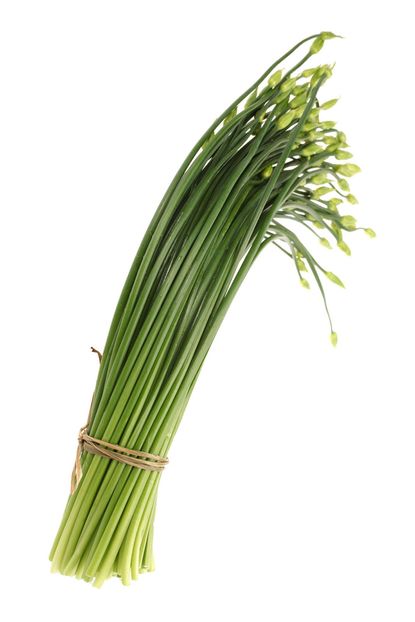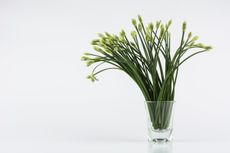Care Of Garlic Chives - How To Grow Wild Garlic Chives Plants


It looks like an onion chive but tastes more like garlic. Garlic chives in the garden are also often referred to as Chinese chives plants and as such was first recorded between 4,000-5,000 years ago in China. So, what are garlic chives and how do they differ from ordinary garden chives?
What are Garlic Chives?
Its scientific name of Allium tuberosum is indicative of its oniony roots and falls among the family Liliaceae. Unlike onions or other types of garlic, however, the fibrous bulb is not edible but is grown rather for its flowers and stems. It is easy to differentiate between onion chives and garlic chives. Garlic chives have a flat, grass-like leaf, not a hollow one as do onion chives. They grow between 12 to 15 inches (30.5 to 38 cm.) tall. Garlic chives make a lovely flower in a border planting or container garden and work well in the herb garden. They can be planted along a path or as a dense ground cover too. The small, star-shaped flowers are usually cream-colored and born on sturdy stems in June. The flowers can be eaten or dried and made into floral arrangements. The seed heads are also often used in everlasting arrangements or can be allowed to remain and drop seeds for continual reseeding. Growing garlic chives are usually cultivated for culinary uses such as in herbal vinegars, salads, soups, soft cheeses, compound butters, and grilled meat. Of course, its ornamental properties are nothing to sneeze at, and, it attracts butterflies.
How to Grow Wild Garlic Chives
I'm betting that everyone will want to know how to grow wild garlic chives in the herb garden, that is if you haven't already. These little perennials can be planted up to USDA zone 3 in full sun exposure and rich, well-draining soil with a pH of 6.0. Transplant or thin to 6 inches (15 cm.). Plant your garlic chives among carrots, grapes, roses, and tomatoes. They will supposedly deter pests such as Japanese beetles, black spot on roses, scab on apples, and mildew on cucurbits. Propagate either from seed or division. Divide the plants in the spring every three years. Propagation from seed may result in an invasion of garlic chives, so you may want to either eat the flowers before they dry and drop seeds or remove and discard them.
Care of Garlic Chives
The care of garlic chives is pretty straightforward. Water as needed; although the plants are drought-tolerant, they do enjoy moist soil. Other care of garlic chives instructs fertilizing them at the start of the growing season with a slow-release fertilizer. After a long-term freeze, garlic chives will often die back only to return again come springtime. Garlic chives not only have a multitude of culinary uses, but are said to be beneficial to the digestive system, stimulate appetites, promote blood circulation, and have diuretic properties. Clip the stems either all the way to the ground or with 2 inches (5 cm.) remaining to allow the herb to grow anew.
Gardening tips, videos, info and more delivered right to your inbox!
Sign up for the Gardening Know How newsletter today and receive a free download of our most popular eBook "How to Grow Delicious Tomatoes."

Amy Grant has been gardening for 30 years and writing for 15. A professional chef and caterer, Amy's area of expertise is culinary gardening.
-
 Urban Composting Guide: How To Compost In The Middle Of The City
Urban Composting Guide: How To Compost In The Middle Of The CityUrban composting does not have to be daunting. You can compost in the city, and maybe even try some urban worm composting!
By Mary Ellen Ellis
-
 Shrub Diseases And Pests To Watch Out For
Shrub Diseases And Pests To Watch Out ForShrub diseases and pests can be challenging. Learn how to recognize and eradicate them before they can present a danger to your plants.
By Susan Albert
